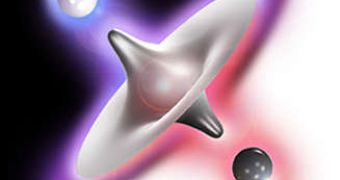Why is there so much matter in the universe, but hardly any antimatter, and where do matter and antimatter actually come from? These are the questions pursued by a team of researchers from the Institut Laue-Langevin in Grenoble, currently preparing to carry out an experiment destined to measure the electrical dipole moment of neutrons. The magnitude of the electrical dipole is a measure to the electric charge distribution inside a sub-atomic particle.
Revealing the value of this constant could open the way to showing the different physical properties of matter and antimatter, as well as the cause for the asymmetry between the two. But first, the facility where the experiment will be conducted must be perfectly insulated from the environment both electrically and magnetically.
A neutron is a composite sub-atomic particle consisting of one up quark and two down quarks. It has neutral electrical charge, since up quarks have a charge of +2/3e and down quarks -1/2e, and a mean life of about 15 minutes, decaying into a proton, an electron and an electron neutrino. It can be imagined as one large positive charge and two negative charges, separated from each other by a minimal distance, thus the neutron should behave like an electrical dipole.
So far, experiments trying to measure the neutron's electrical dipole momentum have failed to detect any, but by studying the behavior of extremely slow neutrons, the ILL team hopes to measure the nEDM with high accuracy. Additionally, because the neutron has a spin, it also possesses a magnetic moment that could bring insight into electromagnetic interactions. Researchers believe that by applying an extra electrical field to the neutron, slight changes in its properties while in a magnetic field would ultimately reveal whether or not neutrons have an electrical dipole moment.
Simply put, the magnitude of the neutron's electrical dipole moment is measured according to the physical differences between matter and antimatter. Measurement uncertainty will be significantly reduced through experiments at the Paul Scherrer Institut, which will be equipped with a strong ultra cold neutron source and a better magnetic shielding.
The Physikalisch-Technische Bundesanstalt is responsible for the magnetic shielding in the ILL experiment and has already collected significant know-how during previous magnetic cabin shield assemblies, which will be used in the building phase for the neutron experiment. Furthermore, equipment already available at the PTB facility will act as preliminary investigation instruments for the components of the experiment.

 14 DAY TRIAL //
14 DAY TRIAL //